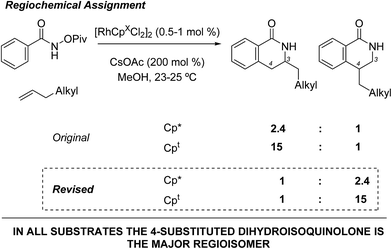 Open Access Article
Open Access ArticleCreative Commons Attribution 3.0 Unported Licence
Correction: Ligand design for Rh(III)-catalyzed C–H activation: an unsymmetrical cyclopentadienyl group enables a regioselective synthesis of dihydroisoquinolones
Todd K.
Hyster
a,
Derek M.
Dalton
a and
Tomislav
Rovis
*ab
aDepartment of Chemistry, Colorado State University, Fort Collins, Colorado 80523, USA. E-mail: rovis@lamar.colostate.edu
bDepartment of Chemistry, Columbia University, 3000 Broadway, New York, NY 12007, USA. E-mail: tr2504@columbia.edu
First published on 15th October 2018
Abstract
Correction for ‘Ligand design for Rh(III)-catalyzed C–H activation: an unsymmetrical cyclopentadienyl group enables a regioselective synthesis of dihydroisoquinolones’ by Todd K. Hyster et al., Chem. Sci., 2015, 6, 254–258.
In the original manuscript, we reported that CptRh(III) complexes enable the highly regioselective coupling of simple alkenes with benzhydroxamate esters forming predominantly the products of 3-substituted dihydroisoquinolones. It has come to our attention that we misassigned the structures and the reaction provides 4-substituted dihydroisoquinolones (the product that we had initially assigned as the minor isomer has proven to be the major isomer). Thus, while the yields and regioselectivities as reported are unchanged, the assignment of the major isomer must be corrected.
Please see Table 1 below, which shows the correct isomer assignments. The information contained in Table 1 is a general example of the correct assignments that should be given, which covers all of the relevant experimental results and the tabulated data contained in the original article.
We are grateful to Professor Dmitry Perekalin (Nesmeyanov Institute of Organoelement Compounds, Russian Academy of Sciences) for bringing this matter to our attention. The authors regret the error.
The original ESI was replaced by a correspondingly revised version on 9th October 2018.
In addition, the authors wish to provide updated affiliation and contact details, and as such affiliation b has been added to the corresponding author of this article. Full details may be found herein.
The Royal Society of Chemistry apologises for these errors and any consequent inconvenience to authors and readers.
| This journal is © The Royal Society of Chemistry 2018 |

